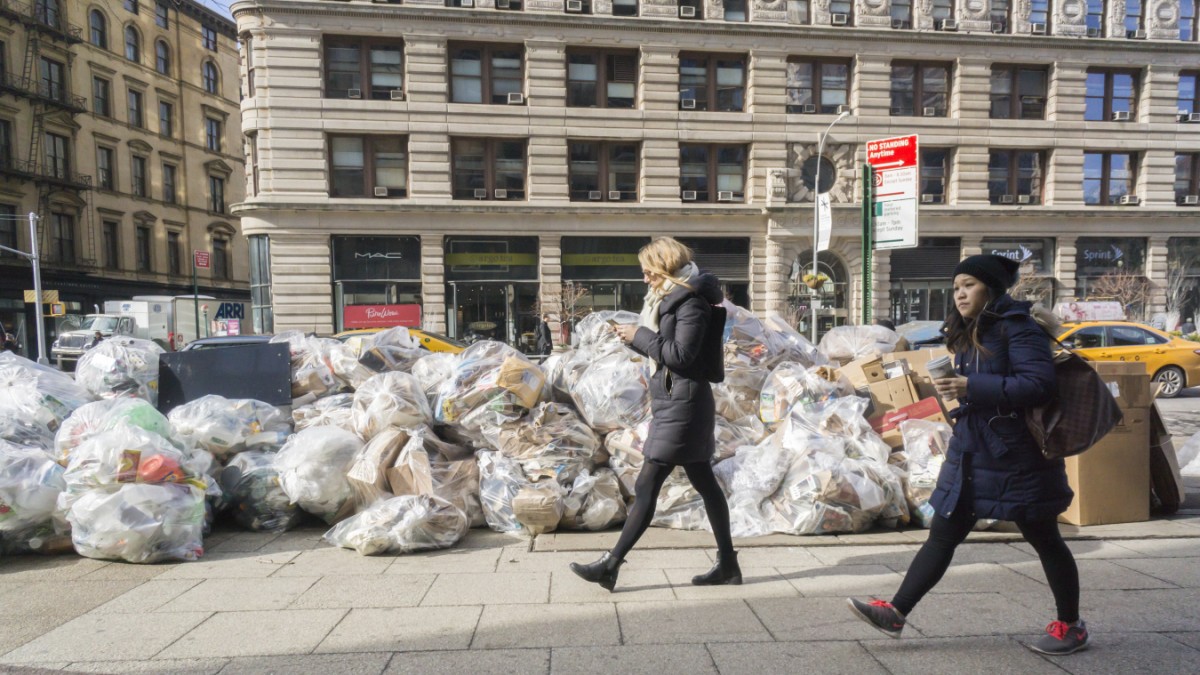Big Apple. There is the scent of orchards, grass and wild flowers in the associative air. The truth is, New York mostly smells of rotten fruit and other unsavory things. The city magazine The Gothamist took the trouble to systematize the situation in 2016 and came to the conclusion: New Yorkers need at least as many different words for their garbage as Eskimos have for snow. Whether on the Upper West Side, in the East Village or in Williamsburg – the black garbage bags are piling up in front of the houses. When the bags are torn and the wind spreads the rubbish, it looks like an ungracious god rained baby diapers, banana peels and Amazon cartons.
“Everyone who comes to New York as a tourist is shocked,” says architect Juliette Spertus. “It is also unusual in the US for garbage to be on the street.”
Basically, garbage disposal in New York follows the classic principle: Each house collects its waste and puts it on the street for collection. That works wonderfully in many American cities, explains Spertus. One-family households are the rule here and there is enough space for garbage cans. But space is expensive in New York and the amounts of waste to be handled are enormous – so the sacks end up on the street. The Department of Sanitation, which is responsible for household waste in the five boroughs of Manhattan, Brooklyn, Queens, Bronx and Staten Island, handles more than 12,000 tons of waste every day. The smallest part of it is currently recyclable. The city saw no need for action for a long time. “It is cheap to dispose of residual waste in landfills outside the city,” explains Spertus. That is about to change, New York wants to be a “Zero Waste City” by 2030, so only a maximum of ten percent of the waste is deposited in landfills.
In New York, there are roughly three categories: household waste, paper and packaging (including glass). This sorting is mandatory. Every private house with five or more floors must have at least one garbage chute accessible from each floor. In the end, it is often the caretakers who pick apart the residents’ garbage.
New York is also a city of extremes when it comes to garbage, explains Spertus. Some New Yorkers would freeze their compostable waste so that it could be taken to the nearest weekly market for further recycling (an offer from the initiative NYC Grow). Others lack garbage awareness. A president who denies climate change is unlikely to change that. Nonetheless, Spertus considers the education factor to be overrated when it comes to waste: “What is the use of knowing how to do it properly if the necessary infrastructure is missing?”
Spertus is co-editor of the “Zero Waste Design Guidelines“. The 260-page document is an appeal to urban planners to think about the waste factor in the future. For Claire Miflin, initiator of the project, this means: designing buildings so that there is enough space for waste disposal. The greatest recycling potential lies in bio-waste, she says – but many buildings have no place at all to store compost separately.
Architect Miflin wants to make waste disposal more attractive with the help of design. The e-commerce portal Etsy shows how this can be done at its headquarters in Brooklyn. There, trash cans under the desks have been abolished, there are three to four central garbage stations on each floor, elaborately designed. Employees are encouraged to avoid waste at best. At the very least, however, they should separate it – and do it correctly: The garbage opening for cardboard boxes has the shape of a slot, packages must be shredded before being thrown in. This may sound natural to European ears, but when you look at the mountains of carton in the streets of New York, the necessity quickly becomes clear. “So far, the issue of waste has been strongly moralized,” says zero-waste advocate Miflin. “We want to show that the less rubbish there is on our streets, the more livable the city becomes for all of us. Many New Yorkers are disgusted with rats – well, something can be done about them.”
While Miflin emphasizes the importance of showcase measures, Juliette Spertus dreams of a real garbage innovation: a pneumatic garbage disposal system is to ban garbage trucks from the city center. In Stockholm and Barcelona, garbage is already being transported to collection points using compressed air through underground pipes. Spertus envisions an above-ground solution for New York – she wants to use the High Line, an old freight train route that was once used to distribute meat from the Meatpacking District. Today the so-called High Line Park is a tourist attraction. And maybe soon part of the municipal waste disposal?
Comparable projects would have cost $ 15 to 25 million, according to Spertus. However: Nobody has ever tried to bring garbage to a height of nine meters using compressed air.
– .

